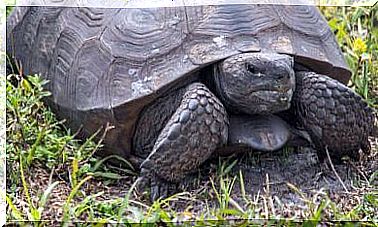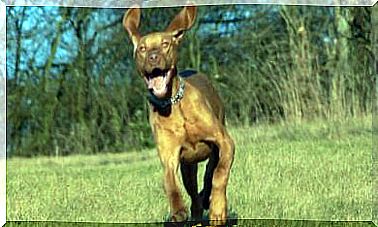5 Tips For Weaning Puppies

Growth is a very important step in all species, as it is the time when all the physiological functions necessary to live properly are developed. Dogs, in particular, are susceptible to developing musculoskeletal disorders and infections if they do not have an adequate childhood. Therefore, knowing how to wean puppies is essential for their long-term well-being.
About 30% of puppies die between birth and weaning in the wild, due to the large number of harmful microorganisms to which they are suddenly exposed. This leads to better canine immunity in the wild, but what a human being wants least is for 3 out of 10 puppies in the litter to die. Here we will present 5 tips so that the weaning of puppies does not end in disaster.
5 tips for weaning puppies
In the early stages of life, puppies live with their mother and siblings without the need to ingest solid food, depending entirely on breast milk. During weaning, puppies need 2 times more energy than adult dogs of the same breed, as they need to achieve specific bone and muscle development, according to experts.
When puppies are weaned, it means they stop relying on breast milk for solid foods. In addition to the simple concept it encompasses, this process requires prior knowledge to be done correctly. Next, we’ll introduce you to 5 tips for weaning puppies.

1. take care of the mother
It is important to provide adequate food for the mother of the puppies at the end of gestation – the last 3 weeks – and during lactation. Only in this way will it be possible to guarantee a good development of the newborn and stability for the female right after birth.
Puppies are born with very little natural immunity and will not fully develop it until around the 16th week of life. Therefore, they depend solely on the mother, who provides them with their immune defenses through milk.
Colostrum, a nutrient-rich milk that a mother produces in the first few days after birth, contains immunoglobulins. These proteins protect puppies from possible illness while their immune system develops.
However, this transfer of vital immunity from the mother is sometimes deficient, so puppies may find themselves at risk until their own immune defense is activated, experts say. This period of a puppy’s development is known as the immunity gap .
During this time, puppies can be more vulnerable to infections. This is the main reason why good nutrition and adequate care for the mother are essential tasks for the health of all members of the dynamic.
2. Know when is the right time to wean puppies
In the first two weeks of life, puppies are prone to dehydration and depend on milk to live. Young dogs are always at risk for viral, bacterial or parasitic infections, but good nutrition during pregnancy, lactation and growth will help reduce these risks.
To avoid problems, puppies can receive dry food – without giving up breast milk – from 2.5 weeks of age and at the latest from the 4th week. At this point, milk no longer provides a complete diet for all puppies. The definitive weaning will arrive in the 6th or 8th week of life.
3. Know what kind of food to offer
A dog’s first food should be very light and contain an intermediate composition between milk and the growth diet. Any food offered must be formulated specifically for puppies, as their nutritional health, as in adult dogs, depends on receiving the correct amounts and proportions of 5 essential nutrients:
- Water .
- Protein.
- Fat.
- Carbohydrates.
- Minerals.
To be considered complete, a puppy food must contain all the essential nutrients except water – which must always be available. These nutrients must also be present in the right proportion to ensure the food is balanced.
Although fat, protein and calcium are generally given the highest profile in puppy food, each essential nutrient is critical. A deficiency in any of these nutrients can compromise the health of the entire litter in the short or long term.
4. Know how to feed them
At full weaning, consumption of solid foods must be high enough to provide the necessary energy and nutrients. This phase is very delicate and a sudden change in diet should be avoided. Also, food intake needs to be regulated during the first 3 days to avoid digestive problems.
Solid foods should be mixed with warm water and left to soak for several minutes, until they reach a porridge-like texture. It is also important to consider the following points:
- Offer the puppies food in small amounts at first and let them lick the porridge.
- Remove any uneaten food after about 10 minutes.
- Offer small meals regularly and increase the amount as the puppies grow, following the feeding guidelines you can find on the food packaging.
Puppies will soon get used to the new flavors and textures. So they can gradually stop consuming moist foods to eventually eat only dry foods. When puppies are one month old, it is important to leave water available at all times.
5. Make a transition to change your food
When puppies move into their new homes, it’s a troublesome time for them because the environment changes drastically. The puppy will have a new vital reference – the human being – a home full of stimuli and a different diet.
Ideally, your feeding goes through a transition period, that is, a time when the puppy will gradually change from the food he used to eat to the new one. It is important because, in addition to the stress caused by a change in the environment, an alteration in the intestinal flora can occur. This would cause diarrhea in the dog and increase the risk of viral or bacterial infections.

Over time, you will notice significant changes in the puppies. If they have a proper weaning stage, you will find that they will grow quickly, play with each other, develop properly, and improve their posture and movement.









